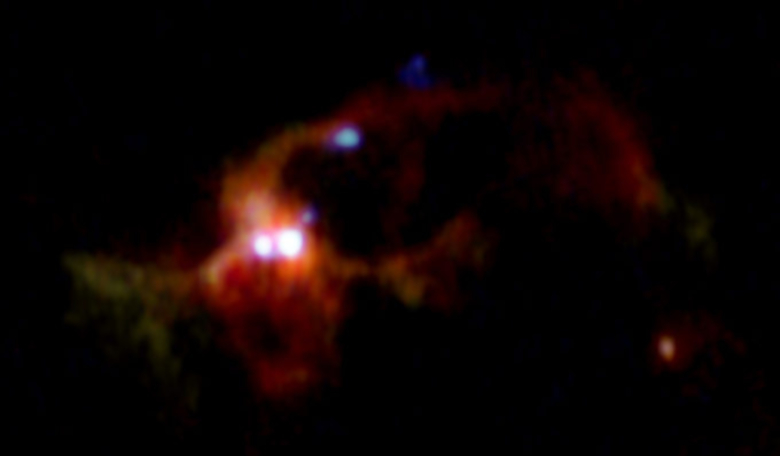Many recipes call for a pinch of salt to be added to a meal to give it that extra flavour, but for astronomers, sodium chloride, is turning out to have another more important use - a marker pointing the way to massive star formation.
9500 light-years away in the constellation Scorpius, astronomers using the Atacama Large Millimeter/submillimeter Array (ALMA) have spotted a pair of massive stars growing in a swirling cloud of heated water vapour and sodium chloride molecules – a compound more commonly known as table salt.
This might seem unusual, and indeed only one other instance has been found so far, but it could have important implications to how some of the most massive stars in the Universe are born.
Stars come in all sizes, or rather masses and it is this seemingly ordinary aspect of a star that is the most important, because it determines how how long the star will live for, what elements it will produce and how it will end its life.
If a star is below eight solar masses it is likely to turn into a planetary nebula and then live out the rest of its life as a white dwarf as it cools and dims.
Stars above eight solar masses tend to end with a bang in a supernova explosion. If the core survives it can end up as a neutron star or contracts to become a black hole if the remaining core is much greater than 3 solar masses.
Mass therefore is everything and perhaps surprisingly, astronomers know more about how small stars like the Sun are formed than they do about the birth of giant stars.
This is for two reasons; one, there are not many massive star formation sites near by - most are located far away the Earth. Secondly, enormous clouds surround massive baby stars with complicated structures making it hard for astronomers to peer through and see what is going on.
Using the resolving power of ALMA to study a massive young binary system known as IRAS 16547-4247, a team of astronomers have been able to overcome these barriers and have honed in on the circumstellar disk surrounding the nascent stars to uncover a number of important clues.
The team, led by Kei Tanaka at the National Astronomical Observatory of Japan, found that molecules such as methyl cyanide (CH3CN), which astronomers commonly observed in previous studies of massive young stars, were detected further out in the star’s natal cloud than anticipated. However closer in, emissions of both sodium chloride and water vapour were detected.
Sodium chloride is not a common molecule in the Universe says Tanaka, so this is only the second detection of sodium chloride around massive young stars.
“The first example was around Orion KL Source I, but that is such a peculiar source that we were unsure whether salt is suitable for seeing gas disks around massive stars,” Tanaka adds. “Our results confirmed that salt is actually a good marker. Since baby stars gain mass through disks, it is important to study the motion and characteristics of disks to understand how the baby stars grow.”
Another important piece of evidence the team found was that the disks are counter-rotating I.e. they are rotating in opposite directions to one another.
This is something of an oddity because if the stars were born as twins in a large common gaseous disk, the disks would naturally rotate in the same direction.
“The counter-rotation of the disks may indicate that these two stars are not actual twins, but a pair of strangers which were formed in separated clouds and paired up later,” explains Yichen Zhang, a researcher at RIKEN and a co-author of the research paper recently submitted to Astrophysical Journal Letters.
Research suggests that most stars, if not all and not just the massive ones start life as a binary. Even our Sun is thought to have a twin somewhere out there.
Recently, scientists have posited that HD 186302 could be the sun’s long-lost sibling, due to its uncanny similarities with our central star. However no one can say with 100 percent certainty that is the case.
While the identity of the Sun’s twin remains unresolved, clues about the origin of the Solar System might be uncovered through studying hot disks with sodium chloride and hot water vapor say Tanaka and colleagues.
The presence of these two compounds, released by the destruction of dust particles in a hot and dynamic disk, aligns well with investigations into meteorites which also indicates that the proto-Solar System disk experienced high temperatures causing dust particles to evaporate.
One day, astronomers will be able to trace these molecules released from dust particles when the next generation Very Large Array (ngVLA), a project to construct a large set of radio telescopes in the US, comes to fruition.











